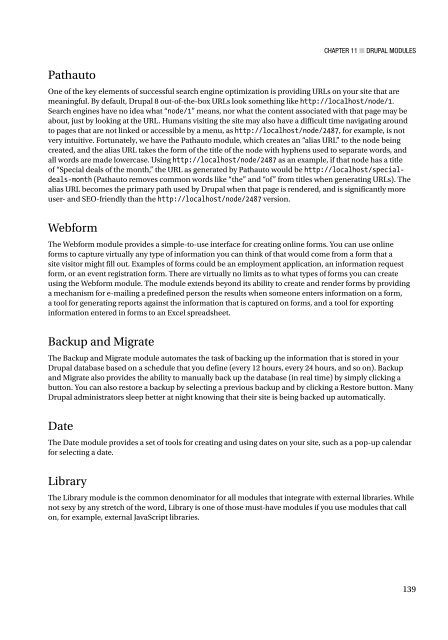Beginning Drupal 8
Todd Tomlinson - Beginning Drupal 8 (The Expert's Voice in Drupal) - 2015
Todd Tomlinson - Beginning Drupal 8 (The Expert's Voice in Drupal) - 2015
Create successful ePaper yourself
Turn your PDF publications into a flip-book with our unique Google optimized e-Paper software.
Pathauto<br />
Chapter 11 ■ <strong>Drupal</strong> Modules<br />
One of the key elements of successful search engine optimization is providing URLs on your site that are<br />
meaningful. By default, <strong>Drupal</strong> 8 out-of-the-box URLs look something like http://localhost/node/1.<br />
Search engines have no idea what “node/1” means, nor what the content associated with that page may be<br />
about, just by looking at the URL. Humans visiting the site may also have a difficult time navigating around<br />
to pages that are not linked or accessible by a menu, as http://localhost/node/2487, for example, is not<br />
very intuitive. Fortunately, we have the Pathauto module, which creates an “alias URL” to the node being<br />
created, and the alias URL takes the form of the title of the node with hyphens used to separate words, and<br />
all words are made lowercase. Using http://localhost/node/2487 as an example, if that node has a title<br />
of “Special deals of the month,” the URL as generated by Pathauto would be http://localhost/specialdeals-month<br />
(Pathauto removes common words like “the” and “of” from titles when generating URLs). The<br />
alias URL becomes the primary path used by <strong>Drupal</strong> when that page is rendered, and is significantly more<br />
user- and SEO-friendly than the http://localhost/node/2487 version.<br />
Webform<br />
The Webform module provides a simple-to-use interface for creating online forms. You can use online<br />
forms to capture virtually any type of information you can think of that would come from a form that a<br />
site visitor might fill out. Examples of forms could be an employment application, an information request<br />
form, or an event registration form. There are virtually no limits as to what types of forms you can create<br />
using the Webform module. The module extends beyond its ability to create and render forms by providing<br />
a mechanism for e-mailing a predefined person the results when someone enters information on a form,<br />
a tool for generating reports against the information that is captured on forms, and a tool for exporting<br />
information entered in forms to an Excel spreadsheet.<br />
Backup and Migrate<br />
The Backup and Migrate module automates the task of backing up the information that is stored in your<br />
<strong>Drupal</strong> database based on a schedule that you define (every 12 hours, every 24 hours, and so on). Backup<br />
and Migrate also provides the ability to manually back up the database (in real time) by simply clicking a<br />
button. You can also restore a backup by selecting a previous backup and by clicking a Restore button. Many<br />
<strong>Drupal</strong> administrators sleep better at night knowing that their site is being backed up automatically.<br />
Date<br />
The Date module provides a set of tools for creating and using dates on your site, such as a pop-up calendar<br />
for selecting a date.<br />
Library<br />
The Library module is the common denominator for all modules that integrate with external libraries. While<br />
not sexy by any stretch of the word, Library is one of those must-have modules if you use modules that call<br />
on, for example, external JavaScript libraries.<br />
139



